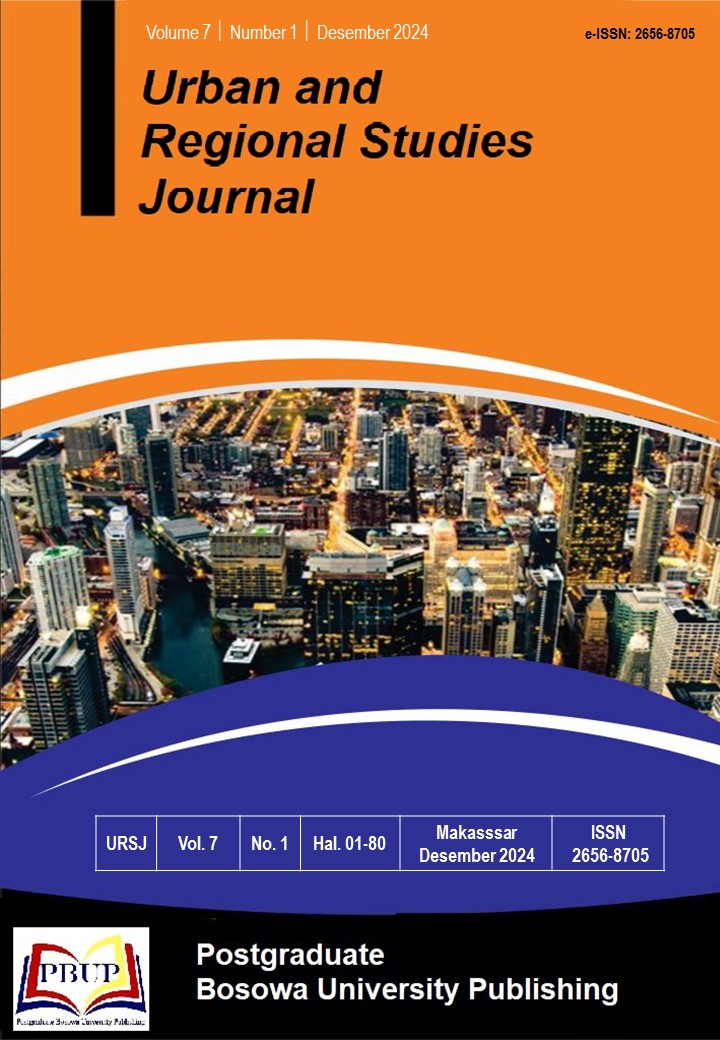Analisis Kawasan Permukiman Kumuh DAS Jeneberang Kota Makassar
DOI:
https://doi.org/10.35965/ursj.v7i1.5502Keywords:
Kawasan Permukiman, Permukiman Kumuh, Daerah Aliran Sungai, Sungai JeneberangAbstract
Penelitian ini menggunakan metode Kuantitatif Survey yang melibatkan pengumpulan data dari sejumlah besar responden menggunakan kuesioner atau wawancara terstruktur. Berdasarkan hasil analisis pengindraan jauh melihat dari 2 tahun berkembangan yang berbeda (Time-lapse) menunjukan bahwa pola bangunan yang berkembang bersifat berkelompok (Radial). Faktor-faktor yang berpengaruh signifikan terhadap perkembangan permukiman kumuh yaitu kepadatan bangunan dan aksesibilitas yang ada. Dalam perumusan konsep penataan permukiman kumuh diperlukan determinan ruang yang di kaitkan dengan tata guna lahan dan pemanfaatan lahan sehingga menghasilkan regulasi yang terintegritas pada aktivitas berkelanjutan DAS Jeneberang.
This study uses a Quantitative Survey method that involves collecting data from a large number of respondents using questionnaires or structured interviews. Based on the results of remote sensing analysis looking at 2 different years of development (Time-lapse) shows that the building patterns that develop are grouped (Radial). Factors that have a significant influence on the development of slums are building density and existing accessibility. In formulating the concept of slum settlement management, spatial determinants are needed that are linked to land use and land utilization so as to produce regulations that are integrated into the sustainable activities of the Jeneberang Watershed.
Downloads
References
Ahmad, R., Hassan, Z., & Malik, S. (2022). Urban sprawl and informal settlements: Impacts of proximity to water bodies. Journal of Urban Planning and Development, 148(3), 05022020.
Ajzen, I. (2020). The theory of planned behavior: Frequently asked questions. Human Behavior and Emerging Technologies, 2(4), 314–324.
Bowen, G. A. (2009). Document analysis as a qualitative research method. Qualitative Research Journal, 9(2), 27–40.
Brinkmann, S., & Kvale, S. (2018). Doing interviews. London: SAGE Publications.
Chen, H., Zhang, J., & Xu, Z. (2021). Influence of community behavior on the development of informal settlements. Urban Studies, 58(7), 1440–1460.
Chen, W., Zhao, H., & Li, J. (2021). The impact of urban expansion on watershed ecosystems: An integrated spatial analysis. Land Use Policy, 108, 105467.
Creswell, J. W., & Creswell, J. D. (2017). Research design: Qualitative, quantitative, and mixed methods approaches (5th ed.). Thousand Oaks, CA: SAGE Publications.
Herold, M., Couclelis, H., & Clarke, K. C. (2020). The role of spatial data and GIS in sustainable urban planning: A review. Journal of Urban Management, 9(2), 97–109.
Johnston, M. P. (2017). Secondary data analysis: A method of which the time has come. Qualitative and Quantitative Research, 3(2), 619–626.
Kawulich, B. B. (2019). Participant observation as a data collection method. Qualitative Social Research, 6(2), Article 43.
Kerlinger, F. N. (1973). Foundations of behavioral research. Holt, Rinehart and Winston.
Li, X., Zhou, Q., & Liu, J. (2022). Accessibility and the evolution of informal settlements: A spatial analysis approach. Land Use Policy, 114, 105970.
Lu, Y., Liang, L., Wang, L., & Yang, Y. (2020). Urban expansion and its ecological effects: A simulation analysis based on land use changes in a coastal city. Sustainability, 12(1), 374.
Moleong, L. J. (2007). Metodologi penelitian kualitatif. Bandung: PT Remaja Rosdakarya.
Rahman, M., Alam, S., & Khan, T. (2023). The role of green spaces in mitigating urban slum expansion: Policy implications. Sustainability, 15(4), 2201.
Rahman, M. A., & Kumar, R. (2023). Urbanization and its implications on water resources in developing countries: A case study of river basin management. Environmental Science and Policy, 138, 45–55.
Ruggiano, N., & Perry, T. E. (2019). Conducting secondary analysis of qualitative data: Should we, can we, and how? Qualitative Social Work, 18(1), 81–97.
Silva, F., & Santos, M. (2023). Building density and quality of life in informal settlements: A geospatial analysis. Habitat International, 132, 102655.
Slamet. (2006). Metode penelitian kualitatif. Surakarta: Universitas Sebelas Maret.
Snyder, H. (2019). Literature review as a research methodology: An overview and guidelines. Journal of Business Research, 104, 333–339.
Tuwu, A. (2006). Metodologi penelitian sosial. Makassar: Universitas Negeri Makassar.
Wang, J., Li, C., & Zhang, Y. (2023). Land availability and informal settlement growth in peri-urban areas. Journal of Urban Management, 12(1), 58–68.
Wang, Y., Liu, Z., & Feng, H. (2022). Evaluating the environmental consequences of urban growth in river catchment areas using GIS and remote sensing. International Journal of Environmental Research and Public Health, 19(10), 6305.
Zhang, H., Li, Q., & Sun, J. (2020). Monitoring urban land-use dynamics and water quality in river basins using remote sensing technologies. Remote Sensing Applications: Society and Environment, 28, 100638.
Downloads
Published
How to Cite
Issue
Section
License
Copyright (c) 2024 Irwan Rudianto, Syafri Syafri, Emil Salim Rasyidi

This work is licensed under a Creative Commons Attribution 4.0 International License.










